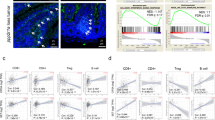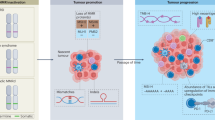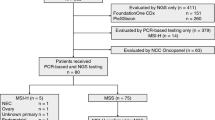Abstract
We studied the genomic instability and methylation status of the mismatch-repair (MMR) genes hMLH1 and hMSH2, and the imprinted genes H19/IGF2, in fetuses with neural tube defects (NTDs) to explore the pathogenesis of the disease. Microsatellite instability (MSI) was observed in 23 of 50 NTD patients. Five NTD patients showed high-degree MSI (MSI-H) and 18 showed low-degree MSI (MSI-L). The frequencies of mutated microsatellite loci were 3/50 (6%) for BatT-25, 10/50 (20%) for Bat-26, 3/50 (6%) for Bat34C4, 6/50 (12%) for D2S123, 4/50 (8%) for D2S119, and 3/50 (6%) for D3S1611. The promoter regions of the hMLH1 and hMSH2 genes were unmethylated in NTD patients, as determined by methylation-specific PCR. The hMLH1 and hMSH2 promoter methylation patterns, the methylation levels of H19 DMR1, and IGF2 DMR0 were detected by bisulfite sequencing PCR, sub-cloning, and sequencing. The hMSH2 promoter sequence was unmethylated, and the hMLH1 promoter showed a specific methylation pattern at two CpG sites. The methylation levels of H19 DMR1 in the NTD and control groups are 73.3%±15.9 and 58.3%±11.2, respectively. The methylation level of the NTD group was higher than that of the control group (Student's t-test, P<0.05). There is no significant difference in IGF2 DMR0 methylation level between the two groups. All of the results presented here suggest that genomic instability, the MMR system, and hyper-methylation of the H19 DMR1 may be correlated with the occurrence of NTDs.
Similar content being viewed by others
Log in or create a free account to read this content
Gain free access to this article, as well as selected content from this journal and more on nature.com
or
References
Greene ND, Stanier P, Copp AJ : Genetics of human neural tube defects. Hum Mol Genet 2009; 18: 113–129.
Li ZW, Ren AG, Zhang L et al: Prevalence of major external birth defects in high and low risk areas in China, 2003. Zhonghua Liu Xing Bing Xue Za Zhi 2005; 26: 252–257.
Malcoe LH, Shaw GM, Lammer EJ, Herman AA : The effect of congenital anomalies on mortality risk in white and black infants. Am J Public Health 1999; 89: 887–892.
Copp AJ, Greene ND : Genetics and development of neural tube defects. J Pathol 2010; 220: 217–230.
MRC Vitamin Study Research Group: Prevention of neural tube defects: results of the Medical Research Council Vitamin Study. MRC Vitamin Study Research Group. Lancet 1991; 338: 131–137.
Grosse SD, Collins JS : Folic acid supplementation and neural tube defect recurrence prevention. Birth Defects Res 2007; 79: 737–742.
Burren KA, Savery D, Massa V et al: Gene–environment interactions in the causation of neural tube defects: folate deficiency increases susceptibility conferred by loss of Pax3 function. Hum Mol Genet 2008; 17: 3675–3685.
Kunkel TA, Erie DA : DNA mismatch repair. Annu Rev Biochem 2005; 74: 681–710.
Ionov Y, Peinado MA, Malkhosyan S, Shibata D, Perucho M : Ubiquitous somatic mutations in simple repeated sequences reveal a new mechanism for colonic carcinogenesis. Nature 1993; 363: 558–561.
Li YC, Korol AB, Fahima T, Nevo E : Microsatellites within genes: structure, function, and evolution. Mol Biol Evol 2004; 21: 991–1007.
Hui J, Hung LH, Heiner M et al: Intronic CA-repeat and CA-rich elements: a new class of regulators of mammalian alternative splicing. EMBO J 2005; 24: 1988–1998.
McKay JA, Williams EA, Mathers JC : Folate and DNA methylation during in utero development and aging. Biochem Soc Trans 2004; 32 (Part 6): 1006–1007.
Salvesen HB, MacDonald N, Ryan A et al: Methylation of hMLH1 in a population-based series of endometrial carcinomas. Clin Cancer Res 2000; 6: 3607–3613.
Riccio A, Sparago A, Verde G et al: Inherited and sporadic epimutations at the IGF2-H19 locus in Beckwith–Wiedemann syndrome and Wilms’ tumor. Endocr Dev 2009; 14: 1–9.
Waterland RA, Jirtle RL : Early nutrition, epigenetic changes at transposons and imprinted genes, and enhanced susceptibility to adult chronic diseases. Nutrition 2004; 20: 63–68.
Cao Z, Song JH, Kim CJ et al: Genetic and epigenetic analysis of the VHL gene in gastric cancers. Acta Oncol 2008; 47: 1551–1556.
Loukola A, Eklin K, Laiho P et al: Microsatellite marker analysis in screening for hereditary nonpolyposis colorectal cancer (HNPCC). Cancer Res 2001; 61: 4545–4549.
Herman JG, Graff JR, Myöhänen S, Nelkin BD, Baylin SB : Methylation-specific PCR: a novel PCR assay for methylation status of CpG islands. Proc Natl Acad Sci USA 1996; 93: 9821–9826.
Park SJ, Rashid A, Lee JH, Kim SG, Hamilton SR, Wu TT : Frequent CpG island methylation in serrated adenomas of the colorectum. Am J Pathol 2003; 162: 815–822.
Herman JG, Umar A, Polyak K et al: Incidence and functional consequences of hMLH1 promoter hypermethylation in colorectal carcinoma. Proc Natl Acad Sci USA 1998; 95: 6870–6875.
Kumaki Y, Oda M, Okano M : QUMA: quantification tool for methylation analysis. Nucleic Acids Res 2008; 36 (Web Server issue): W170–W175.
Heil SG, Riksen NP, Boers GH, Smulders Y, Blom HJ : DNA methylation status is not impaired in treated cystathionine beta-synthase (CBS) deficient patients. Mol Genet Metab 2007; 91: 55–60.
Cui H, Onyango P, Brandenburg S, Wu Y, Hsieh CL, Feinberg AP : Loss of imprinting in colorectal cancer linked to hypomethylation of H19 and IGF2. Cancer Res 2002; 62: 6442–6446.
Sparago A, Cerrato F, Vernucci M : Microdeletions in the human H19 DMR result in loss of IGF2 imprinting and Beckwith–Wiedemann syndrome. Nat Genet 2004; 36: 958–960.
Gu X, Lin L, Zheng X et al: High prevalence of NTDs in Shanxi province: a combined epidemiological approach. Birth Defects Res A Clin Mol Teratol 2007; 79: 702–707.
Deschoolmeester V, Baay M, Wuyts W et al: Detection of microsatellite instability in colorectal cancer using an alternative multiplex assay of quasi-monomorphic mononucleotide markers. J Mol Diagn 2008; 10: 154–159.
Viana-Pereira M, Almeida I, Sousa S et al: Analysis of microsatellite instability in medulloblastoma. Neuro Oncol 2009; 11: 458–467.
Rubio-Del-Campo A, Salinas-Sánchez AS, Sánchez-Sánchez F et al: Implications of mismatch repair genes hMLH1 and hMSH2 in patients with sporadic renal cell carcinoma. BJU Int 2008; 102: 504–509.
Stuckless S, Parfrey PS, Woods MO et al: The phenotypic expression of three MSH2 mutations in large Newfoundland families with Lynch syndrome. Fam Cancer 2007; 6: 1–12.
Köster F, Schröer A, Fischer D, Greweldinger T, Diedrich K, Friedrich M : Correlation of DNA mismatch repair protein hMSH2 immunohistochemistry with p53 and apoptosis in cervical carcinoma. Anticancer Res 2007; 27: 63–68.
Gazzoli I, Loda M, Garber J, Syngal S, Kolodner RD : A hereditary nonpolyposis colorectal carcinoma case associated with hypermethylation of the MLH1 gene in normal tissue and loss of heterozygosity of the unmethylated allele in the resulting microsatellite instability-high tumor. Cancer Res 2002; 62: 3925–3928.
Imai K, Yamamoto H : Carcinogenesis and microsatellite instability: the interrelationship between genetics and epigenetics. Carcinogenesis 2008; 29: 673–680.
Demars J, Shmela ME, Rossignol S et al: Analysis of the IGF2/H19 imprinting control region uncovers new genetic defects, including mutations of OCT-binding sequences, in patients with 11p15 fetal growth disorders. Hum Mol Genet 2010; 19: 803–814.
Chao W, D′Amore PA : IGF2: epigenetic regulation and role in development and disease. Cytokine Growth Factor Rev 2008; 19: 111–120.
Young LE, Fernandes K, McEvoy TG et al: Epigenetic change in IGF2R is associated with fetal overgrowth after sheep embryo culture. Nat Genet 2001; 27: 153–154.
Byun HM, Wong HL, Birnstein EA et al: Examination of IGF2 and H19 loss of imprinting in bladder cancer. Cancer Res 2007; 67: 10753–10758.
Murrell A, Ito Y, Verde G et al: Distinct methylation changes at the IGF2-H19 locus in congenital growth disorders and cancer. PLoS One 2008; 3: e1849.
Wang L, Wang F, Guan J et al: Relation between hypomethylation of long interspersed nucleotide elements. Am J Clin Nutr 2010; 91: 1359–1367.
Delaval K, Feil R : Epigenetic regulation of mammalian genomic imprinting. Curr Opin Genet Dev 2004; 14: 188–195.
Ito Y, Koessler T, Ibrahim AE et al: Somatically acquired hypomethylation of IGF2 in breast and colorectal cancer. Hum Mol Genet 2008; 17: 2633–2643.
Acknowledgements
This work was supported by the National Basic Research Program of China ‘973’ (2007CB511903), the National Natural Science Foundation of China (30671156), and Beijing Natural Science Foundation (5072014).
Author information
Authors and Affiliations
Corresponding author
Ethics declarations
Competing interests
The authors declare no conflict of interest.
Additional information
Supplementary Information accompanies the paper on European Journal of Human Genetics website
Rights and permissions
About this article
Cite this article
Liu, Z., Wang, Z., Li, Y. et al. Association of genomic instability, and the methylation status of imprinted genes and mismatch-repair genes, with neural tube defects. Eur J Hum Genet 20, 516–520 (2012). https://doi.org/10.1038/ejhg.2011.242
Received:
Revised:
Accepted:
Published:
Issue date:
DOI: https://doi.org/10.1038/ejhg.2011.242
Keywords
This article is cited by
-
Embryonic exposure to decitabine induces multiple neural tube defects in developing zebrafish
Fish Physiology and Biochemistry (2023)
-
Genetic Polymorphisms in DNA Repair Gene APE1/Ref-1 and the Risk of Neural Tube Defects in a High-Risk Area of China
Reproductive Sciences (2021)
-
Maternal Folic Acid Supplementation Mediates Offspring Health via DNA Methylation
Reproductive Sciences (2020)
-
Aberrant methylation of Pax3 gene and neural tube defects in association with exposure to polycyclic aromatic hydrocarbons
Clinical Epigenetics (2019)
-
TRIM4 is associated with neural tube defects based on genome-wide DNA methylation analysis
Clinical Epigenetics (2019)



